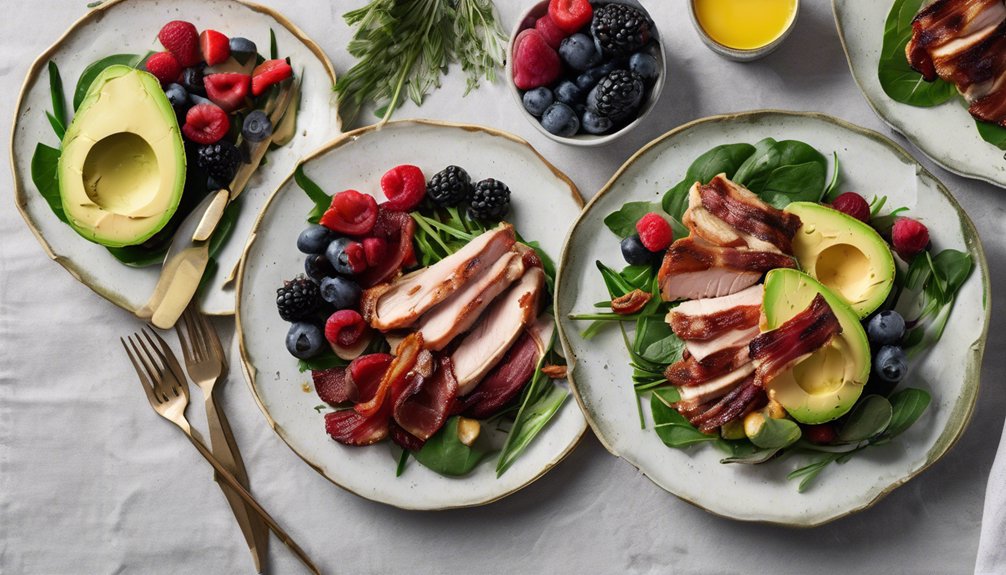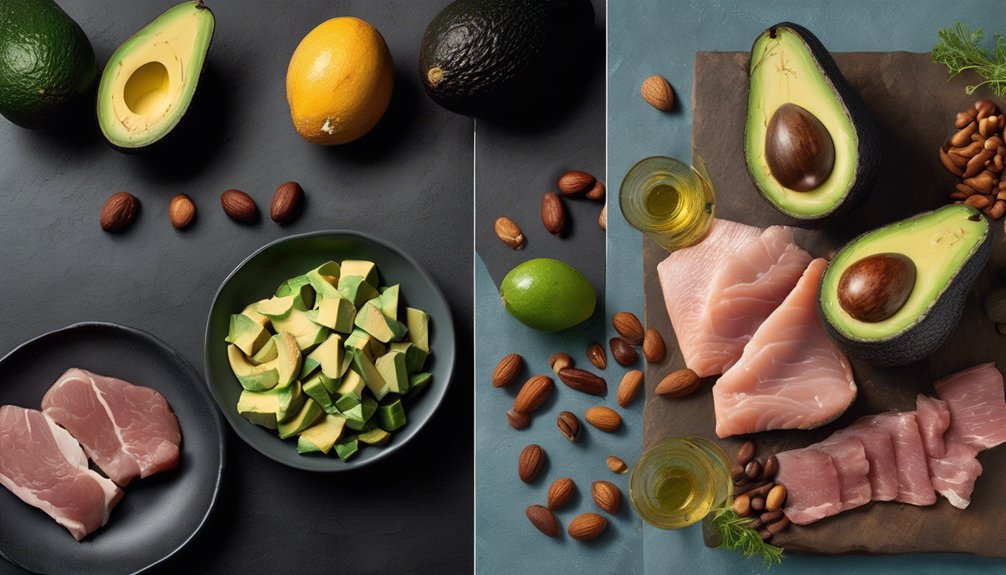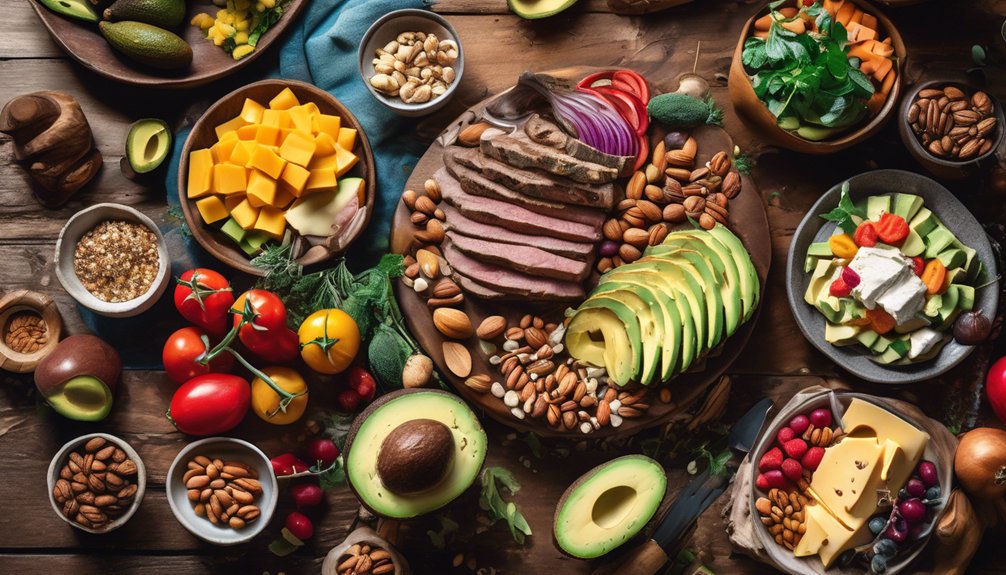Keto vs. Paleo What’s Healthier
When it comes to choosing between the Keto and Paleo diets, understanding their core principles is essential. Keto focuses on high fat and low carbs, while Paleo emphasizes whole, unprocessed foods. Each diet has its unique benefits and potential drawbacks, which can impact your health goals. So, how do you decide which one might be the best fit for you? Let's explore the details to help clarify your options.
Key Takeaways
- The Keto diet promotes rapid weight loss through ketosis by focusing on high fat and low carbohydrate intake.
- The Paleo diet emphasizes whole, unprocessed foods, which may lead to better overall nutrition without strict macronutrient ratios.
- Keto can improve metabolic health and mental clarity, while Paleo encourages better digestion and overall wellness.
- Potential nutrient deficiencies in Paleo may arise from excluding dairy, while Keto requires careful meal planning to sustain.
- Choosing between Keto and Paleo depends on individual health goals, lifestyle preferences, and dietary sustainability.
Understanding the Keto Diet
When you dive into the Keto diet, you'll quickly discover it focuses on drastically reducing carbohydrate intake while increasing fats, which puts your body into a state called ketosis.
Understanding the keto basics is essential; the typical macronutrient ratios are about 70% fat, 25% protein, and 5% carbs. This ketosis process allows your body to burn fat for fuel, often leading to weight loss.
Effective meal planning becomes crucial, as you'll need to choose healthy fat sources like avocados, nuts, and olive oil.
Be wary of common misconceptions, such as thinking all fats are bad. Long-term sustainability can be challenging, but with creative recipe ideas, you can enjoy delicious meals while staying on track with your goals.
Key Principles of the Paleo Diet
The Paleo diet, often seen as a counterpart to the Keto approach, emphasizes whole, unprocessed foods that our ancestors might've eaten during the Paleolithic era.
By focusing on paleo food like lean meats, fish, fruits, vegetables, nuts, and seeds, you're aligning with ancestral eating principles that promote healthier choices.
The idea is to eliminate processed foods, grains, legumes, and dairy, which our ancestors didn't consume. This can lead to improved digestion, weight management, and overall wellness.
You'll also find that the Paleo diet encourages mindfulness in food selection, fostering a deeper connection with what you eat.
Nutritional Differences Between Keto and Paleo
While both the Keto and Paleo diets promote whole foods, their nutritional compositions differ significantly.
The Keto diet focuses on high fat, moderate protein, and very low carbohydrates, often aiming for a macronutrient ratio of about 70% fat, 25% protein, and 5% carbs. This encourages your body to enter ketosis, using fat as its primary fuel source.
In contrast, the Paleo diet emphasizes whole, unprocessed foods like fruits, vegetables, nuts, and lean meats, without strict macronutrient ratios. You'll find a broader range of food sources in Paleo, allowing for natural sugars and healthy carbs.
Understanding these differences can help you choose the diet that aligns with your health goals and lifestyle preferences.
Health Benefits of the Keto Diet
As you explore the health benefits of the Keto diet, you might discover its potential to promote weight loss and improve metabolic health. By focusing on nutrient-dense ketogenic foods, you can reduce your blood sugar levels, which helps manage insulin resistance.
Many people also report enhanced mental clarity, making it easier to focus and stay productive throughout the day. Additionally, the Keto diet encourages heart health through healthy fats and reduced carbohydrates, which can lower cholesterol levels.
Effective meal planning is crucial for success and helps you incorporate these lifestyle changes seamlessly. Overall, embracing the Keto diet may not only support your weight loss goals but also contribute to long-term health benefits that enhance your quality of life.
Health Benefits of the Paleo Diet
How can the Paleo diet contribute to your overall well-being? By emphasizing whole, unprocessed foods, the Paleo diet promotes nutrient density, ensuring you get essential vitamins and minerals in every meal.
This lifestyle encourages you to source your food mindfully, focusing on lean meats, fish, fruits, vegetables, nuts, and seeds, while avoiding processed items. As a result, you may experience improved energy levels, better digestion, and enhanced mental clarity.
The emphasis on healthy fats, like those from avocados and nuts, can also support heart health. Additionally, by eliminating grains and legumes, some people find they experience fewer digestive issues.
Ultimately, the Paleo diet fosters a deeper connection with what you consume, nurturing both your body and mind.
Potential Drawbacks of the Keto Diet
Although the keto diet can offer significant weight loss and metabolic benefits, it also comes with potential drawbacks that you should consider. One major concern is nutrient deficiencies. By drastically reducing carbohydrates, you might miss out on essential vitamins and minerals found in fruits and whole grains. Over time, this can lead to health issues that impact your well-being.
Additionally, the long-term sustainability of the keto diet can be challenging. Many people find it hard to maintain such a restrictive eating pattern, which could lead to yo-yo dieting and frustration.
It's important to weigh these factors carefully. If you're considering keto, think about how it fits into your lifestyle and whether you can commit to it in the long run.
Potential Drawbacks of the Paleo Diet
While the paleo diet emphasizes whole foods and eliminates processed items, it also presents potential drawbacks that deserve your attention. You might encounter nutrient deficiencies, especially in calcium and vitamin D, since dairy is excluded. Flexibility issues arise, making it challenging to dine out or enjoy social meals. Additionally, sustainability concerns come into play; sourcing grass-fed meats and organic produce can be expensive and not always environmentally friendly. Lastly, the limited food variety might make it tough to stick to over time. Here's a quick overview:
| Drawback | Description |
|---|---|
| Nutrient Deficiencies | Risk of lacking essential nutrients |
| Flexibility Issues | Hard to maintain in social settings |
| Sustainability Concerns | Environmental and cost-related issues |
| Food Variety | Limited options can lead to boredom |
Which Diet Fits Your Lifestyle?
Choosing the right diet often hinges on your personal lifestyle, preferences, and health goals. Both the Keto and Paleo diets offer unique benefits, but their lifestyle compatibility and dietary flexibility can make a big difference for you.
Consider these factors:
- Daily Routine: Evaluate how each diet fits into your life—do you prefer meal prepping or spontaneous eating?
- Food Preferences: Think about whether you enjoy high-fat foods or a variety of fruits and vegetables.
- Social Settings: Reflect on how each diet affects dining out or social gatherings.
- Health Goals: Identify your specific objectives—weight loss, muscle gain, or improved energy levels.
Ultimately, choose the diet that resonates with you and supports your journey towards better health.
Making the Choice: Keto or Paleo?
What factors should you consider when deciding between the Keto and Paleo diets?
First, think about your lifestyle and preferences. Keto offers more flexibility, allowing for higher protein intake and some dairy, while focusing on low carbs. If you enjoy meal diversity and flexibility, Keto may suit you better.
On the other hand, Paleo emphasizes whole foods, which can lead to better long-term sustainability. If you value a diet rooted in natural foods, Paleo might be your path.
Consider your health goals, too; Keto can be effective for weight loss, while Paleo promotes overall wellness.
Ultimately, the choice hinges on what resonates with you and fits seamlessly into your life. Choose the plan that feels sustainable and fulfilling for your unique journey.
Frequently Asked Questions
Can I Combine Elements of Both Diets Effectively?
Absolutely, you can combine elements of both diets effectively. Embracing dietary flexibility allows you to create meals that promote nutrient balance, ensuring you enjoy a variety of foods while meeting your health goals. Enjoy the journey!
How Do These Diets Impact Mental Health?
These diets can enhance mental clarity and promote mood stability by balancing blood sugar levels and providing essential nutrients. You might notice improved focus and emotional resilience as you adjust your eating habits and prioritize whole foods.
Are There Specific Foods to Avoid on Both Diets?
When it comes to food restrictions, you'll find both diets have their no-gos. Think processed sugars and grains for Keto, while Paleo avoids dairy and legumes. These diet comparisons can help you navigate your choices effectively.
What Are the Long-Term Sustainability Issues for Each Diet?
Long-term sustainability issues for each diet often revolve around adherence and flexibility. You might find strict rules challenging over time, potentially leading to frustration. Balancing enjoyment with health goals is crucial for lasting success.
How Do These Diets Affect Athletic Performance?
When considering athletic performance, you'll find carbohydrate metabolism crucial for quick energy. However, fat adaptation from certain diets can enhance endurance. Balancing these aspects can optimize your performance, depending on your specific athletic goals.
Conclusion
In deciding between Keto and Paleo, it's crucial to consider your personal health goals and preferences. Did you know that studies show nearly 50% of people on the Keto diet report significant weight loss in the first month? While both diets have their merits, the best choice for you hinges on how each aligns with your lifestyle and nutritional needs. Ultimately, it's about finding a sustainable approach that supports your overall well-being.










